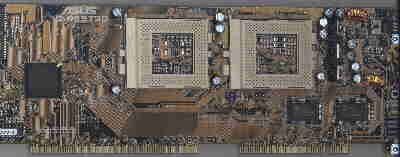Review of Socket 7 PCI Motherboards
Asus
AsusTek P/I P65 UP5 W/ CPU Card C-P55 T2D
A very special board ist the Asus P65 UP5. You have to buy a CPU card for either two Pentium CPUs or another card for two Pentium Pro CPUs. Since AMD or Cyrix/IBM CPUs do not support multi processor architecture, the only suitable CPUs are the Intel Pentium or Pentium Pro. In spite of the various processor configuration possibilities, Winstone does not benefit of a second CPU, so I did not benchmark the dual CPU configuration, of course. Unfortunately this board does not support more than 66 MHz bus speed; I would have liked benchmarking a Pentium Pro at 75 x 3 (= 225 MHz)! This lack limits the qualification for some CPUs running at 75 MHz (6x86-PR200 and 6x86MX-PR233). Due to this restriction, you will just find results for the K6 at 233 MHz and Pentium MMX at 233 MHz (both 66 MHz bus). I think it has to be mentioned that I could tune up all memory settings to maximum (r/w bursts: x-2-2-2, turbo leadoff etc.) without any problems. If you're thinking about obtaining this board, please take into account the size and position of the CPU card. In most cases the HDD bays use exactly the space the CPU card would occupy, so please plan on a large scale and get a server case.

Baby AT format, AT power supply, chipset on CPU card; 3x ISA, 5x PCI, 1x Asus Media Bus extension; 8x SIMM; Award flash BIOS; cache on CPU card (socket 7) or on CPU (P6); external frequencies: 60, 66 MHz; I/O chip: Winbond; busmaster DMA 2 or PIO 4 onboard; FDC onboard; 2x serial 16550; 1x EPP/ECP parallel; 1x PS/2 mouse (without connector); 1x USB (without connector); IrDA support; SDMS support ver. 3.07.

Dual processor socket 7 CPU card; Intel 430HX chipset; 512 kB PB-Cache (6 ns); external frequencies: 50, 60, 66 MHz; BF2 jumper not equipped; core voltages: 2.9V, 2.8V, 2.7V, 2.5V.
Stay On the Cutting Edge: Get the Tom's Hardware Newsletter
Get Tom's Hardware's best news and in-depth reviews, straight to your inbox.